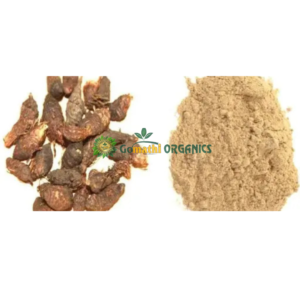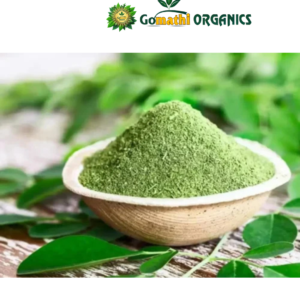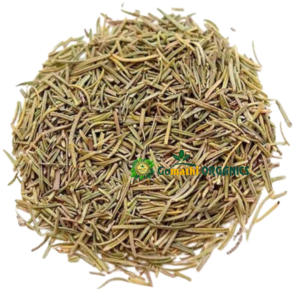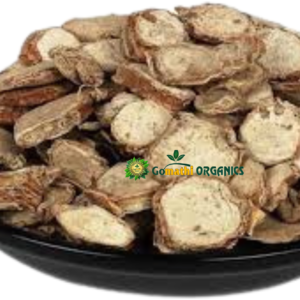What is Puliyam Mara Patta (Tamarind Bark)?
🌳 Puliyam Mara Patta (Tamarindus indica), commonly known as Tamarind Bark, is a widely used herbal ingredient in Ayurveda, Siddha, and Unani medicine.
🌳 The bark, leaves, fruit, and seeds of the Tamarind tree have medicinal properties that help in digestive health, inflammation relief, and skin disorders.
🌳 Native to tropical Africa, the Tamarind tree is now extensively grown in India, Sri Lanka, Southeast Asia, and other tropical regions.
Description of Puliyam Mara Patta (Tamarind Bark) Plant
🌿 Tamarindus indica is a large evergreen tree that grows up to 12–25 meters in height.
🌿 The bark is rough, dark brown to reddish-gray, and used for its astringent and antibacterial properties.
🌿 Leaves are small, feathery, and arranged in pinnate formation, closing at night.
🌿 The tree produces small, yellow flowers with red streaks.
🌿 The fruit is a long, brown pod filled with tangy pulp, widely used in cooking and medicine.
🌿 The bark contains tannins, flavonoids, and polyphenols, making it effective for wound healing, joint pain, and detoxification.
Morphological Characteristics of Puliyam Mara Patta (Tamarind Bark)
🌿 A large, spreading tree with a dense, umbrella-shaped canopy.
🌿 The bark is deeply fissured, dark brown, and rough, with medicinal properties.
🌿 Leaves are compound, bright green, and close at night due to nyctinasty (sleep movement).
🌿 Flowers are small, pale yellow with red or orange streaks, blooming in clusters.
🌿 The fruit is a curved, bean-like pod, brown when mature, containing sticky, sour pulp and hard black seeds.
🌿 The bark is used to treat diarrhea, fever, inflammation, and skin infections.
Habitat of Puliyam Mara Patta (Tamarind Bark) – Tamarindus indica
🌿 Tamarindus indica is native to Africa but widely grown in India, Sri Lanka, Southeast Asia, the Middle East, and tropical America.
🌿 Found in forests, dry plains, village farmlands, and temple courtyards.
🌿 Adaptable to various soil types, including sandy, loamy, and lateritic soils.
🌿 Thrives in hot, dry climates but can also withstand humid and tropical conditions.
🌿 Grows abundantly in Tamil Nadu, Karnataka, Andhra Pradesh, Maharashtra, and Gujarat.
Puliyam Mara Patta (Tamarind Bark) Organic Information
🌳 100% natural and chemical-free, sourced from wild and organic tamarind trees.
🌳 Carefully harvested, sun-dried, and processed to preserve its therapeutic potency.
🌳 Used in traditional medicine for digestive relief, detoxification, and joint health.
🌳 Supports sustainable harvesting practices, ensuring environmental conservation.
🌳 Ethically sourced to provide the purest form of Tamarind Bark for herbal remedies.
Different Language Names
⭐ Tamil: புளிய மரப்பட்டை (Puliyam Mara Pattai)
⭐ Hindi: इमली की छाल (Imli Ki Chhal)
⭐ Sanskrit: तिन्तिडिक त्वक् (Tintidika Tvak), अम्लफल त्वचा (Amlaphala Tvacha)
⭐ Malayalam: പുളിയ മരം തോൽ (Puliya Maram Thol)
⭐ Kannada: ಹುಣಸೆ ಮರದ ತೊಗಟೆ (Hunase Marada Togate)
⭐ Telugu: చింత చెట్టు తొక్క (Chinta Chettu Tokka)
⭐ Bengali: তেঁতুল গাছের ছাল (Tetul Gacher Chhal)
⭐ Marathi: चिंचोफळी साल (Chinchophali Saal)
⭐ Gujarati: અંબલી ની છાલ (Ambli Ni Chhal)
⭐ Punjabi: ਇਮਲੀ ਦੀ ਛਾਲ (Imli Di Chhal)
⭐ Odia: ଟେଂଗୁ ଗଛ ଛାଲ (Tengu Gacha Chhal)
⭐ Assamese: টেঁমুল গছৰ ছাল (Temul Gasor Chhal)
⭐ Urdu: املی کی چھال (Imli Ki Chhal)
⭐ Konkani: ಚಿಂಚು ಮರದ ಸಿಪ್ಪೆ (Chinchu Marada Sippe)
⭐ Tulu: ಹುಣಸೆ ಸಿಪ್ಪೆ (Hunase Sippe)
⭐ Meitei (Manipuri): তেঁতুল গছৰ ছাল (Tetul Gachor Chhal)
⭐ Dogri: इमली की छाल (Imli Ki Chhal)
⭐ Kashmiri: املی چھال (Imli Chhal)
⭐ Maithili: इमली छाल (Imli Chhal)
⭐ Chhattisgarhi: इमली छाल (Imli Chhal)
⭐ Rajasthani: इमली छाल (Imli Chhal)
⭐ Sindhi: املی جي ڇال (Imli Ji Chhal)
⭐ Nepali: इमली छाल (Imli Chhal)
⭐ Arabic: لحاء التمر الهندي (Lihā’ Al-Tamar Hindi)
⭐ Chinese: 罗望子树皮 (Luówàngzǐ Shùpí)
⭐ Malay (Malaysia): Kulit Pokok Asam Jawa
⭐ Thai: เปลือกต้นมะขาม (Pluak Ton Makham)
⭐ Vietnamese: Vỏ cây Me
⭐ Spanish: Corteza del Árbol de Tamarindo
⭐ French: Écorce de Tamarinier
⭐ Sri Lankan Sinhala: සියාඹල ගස් පතල (Siyambala Gas Patala)
⭐ Indonesian: Kulit Pohon Asam
⭐ German: Tamarindenbaumrinde
⭐ Italian: Corteccia dell’Albero di Tamarindo
⭐ Family Name: Fabaceae (Legume family)
⭐ Botanical (Latin) Name: Tamarindus indica
⭐ Common Names: Tamarind Tree Bark, Indian Date Bark, Amlika Bark
Nutritional Information (per 100g)
Energy: 180-230 kcal
Carbohydrates: 35-45g
Dietary Fiber: 10-15g
Protein: 4-8g
Calcium: 120-180mg
Iron: 3-6mg
Vitamin C: 15-25mg
Phytochemicals: Alkaloids, Tannins, Flavonoids, Saponins
Nutritional Facts
✔ Supports digestive health and relieves acidity.
✔ Rich in antioxidants, promoting immune function.
✔ Contains natural anti-inflammatory and antimicrobial properties.
✔ Aids in detoxification and supports liver health.
✔ Free from artificial colors, flavors, and preservatives.
Dosage
For Adults: 1-2 teaspoons (3-5g) per day.
For Children: ½ teaspoon (1-2g) per day.
Maximum Dosage: Do not exceed 10g per day unless recommended by a healthcare professional.
How to Consume
Internal Use
Puliyam Mara Pattai Powder with Water: Mix 1 teaspoon of powder in warm water and drink daily.
Puliyam Mara Pattai Tea: Boil 1 teaspoon of bark in water, strain, and drink.
With Honey: Mix the powder with honey and consume for added benefits.
External Use
For Skin Care: Make a paste with water or rose water and apply it to wounds, rashes, or skin irritations.
For Oral Health: Use the powder as a natural toothpowder to support oral hygiene.
How to Use & Store
✔ Store in an airtight container, away from moisture and direct sunlight.
✔ Ensure the lid is tightly closed after every use.
✔ Keep in a cool, dry place to maintain freshness and potency.
Caution to Be Taken
⚡ Consult a physician if pregnant, breastfeeding, or on medication.
⚡ Possible interactions with medications, especially those affecting digestion, acidity, and blood sugar levels.
⚡ Avoid excessive consumption to prevent potential toxicity or adverse effects.
⚡ Not suitable for infants or children without medical advice.
⚡ Long-term use is not recommended without professional guidance.
⚡ Always consult a healthcare provider for personalized dosage and safety considerations.
Important Tips
☀️ Start with a Low Dose 🌱: Begin with a small amount to assess tolerance.
☀️ Use in Moderation 🌿: Avoid excessive or prolonged use without guidance.
☀️ Choose High-Quality Products 🍁: Purchase from trusted sources to ensure purity and effectiveness.
☀️ Conduct a Patch Test 🍂: Always test on a small skin area before topical application.
☀️ Proper Storage Matters 🍃: Store in airtight, non-metal containers to preserve potency and freshness.
Harvesting & Manufacturing Method
☀️ Organically Sourced 🌳: Puliyam Mara Patta (Tamarind Tree Bark) is cultivated without synthetic chemicals, ensuring natural purity.
☀️ Sustainably Harvested 🌿: Collected from naturally growing tamarind trees in ecologically balanced regions.
☀️ Handpicked & Sun-Dried 🌱: Dried naturally under the sun to retain its medicinal properties.
☀️ No Additives or Chemicals 🌾: Processed without artificial preservatives, maintaining its raw and authentic nature.









Reviews
There are no reviews yet.